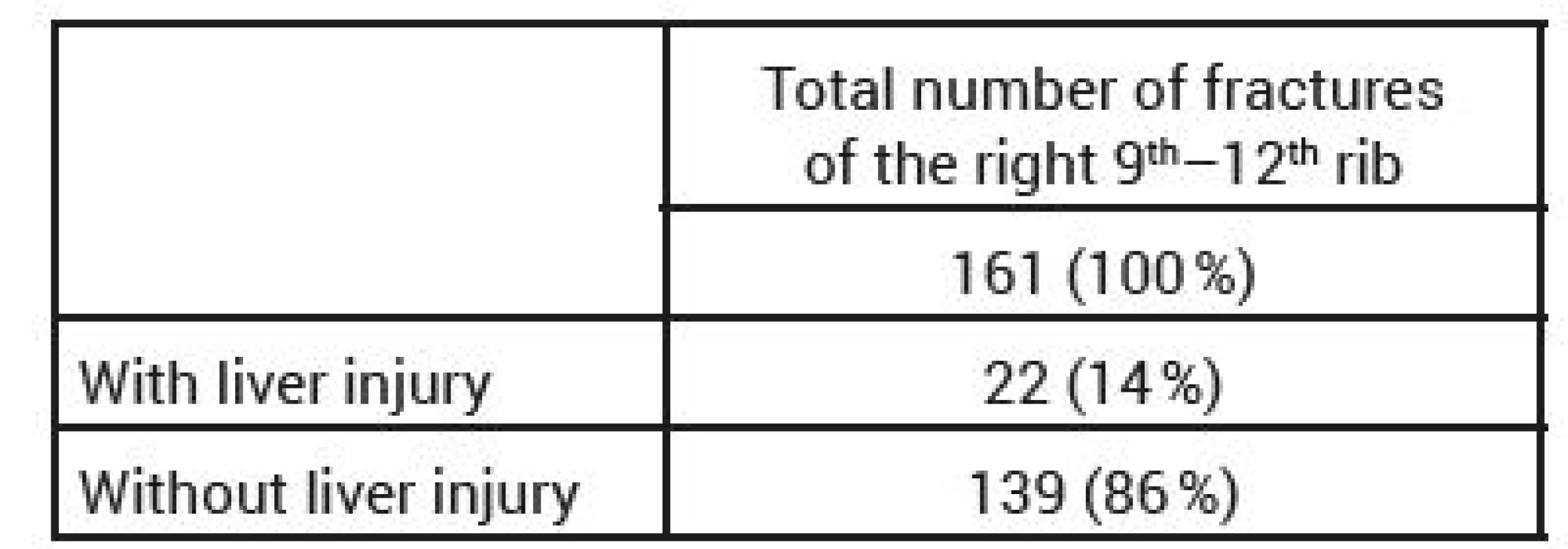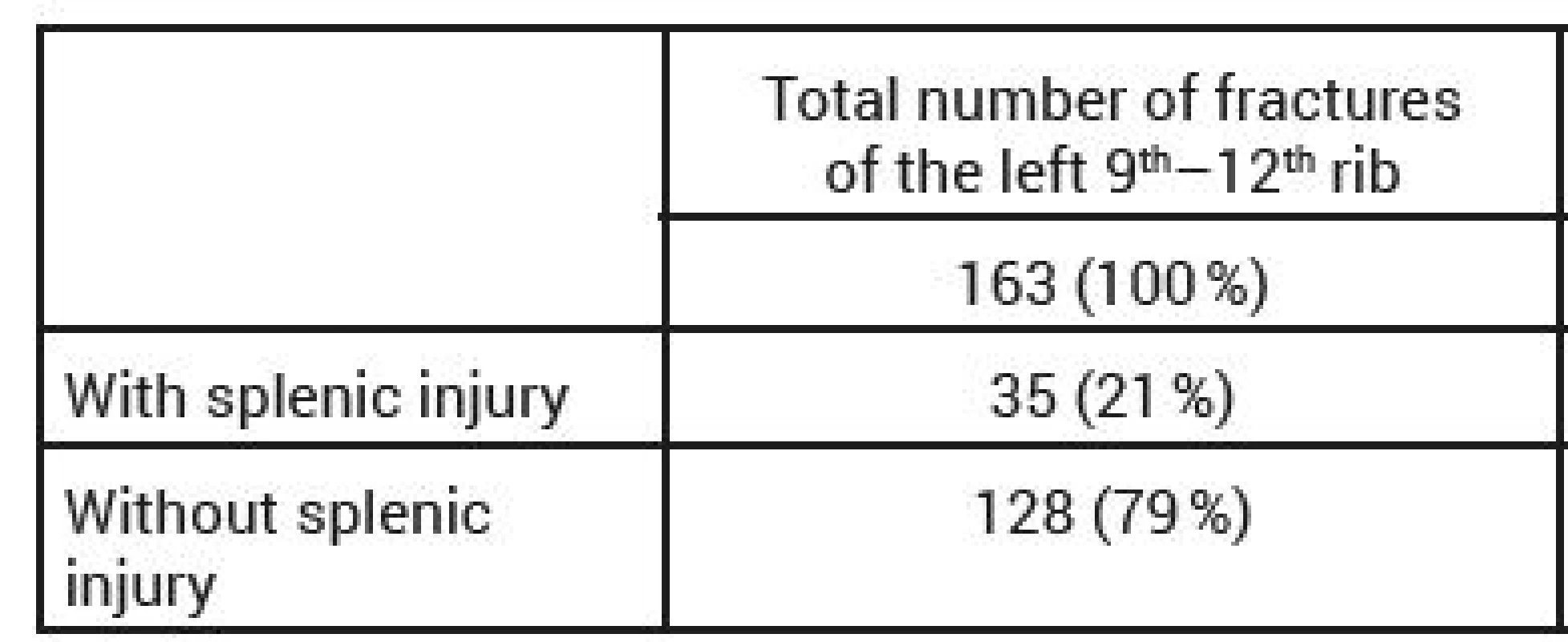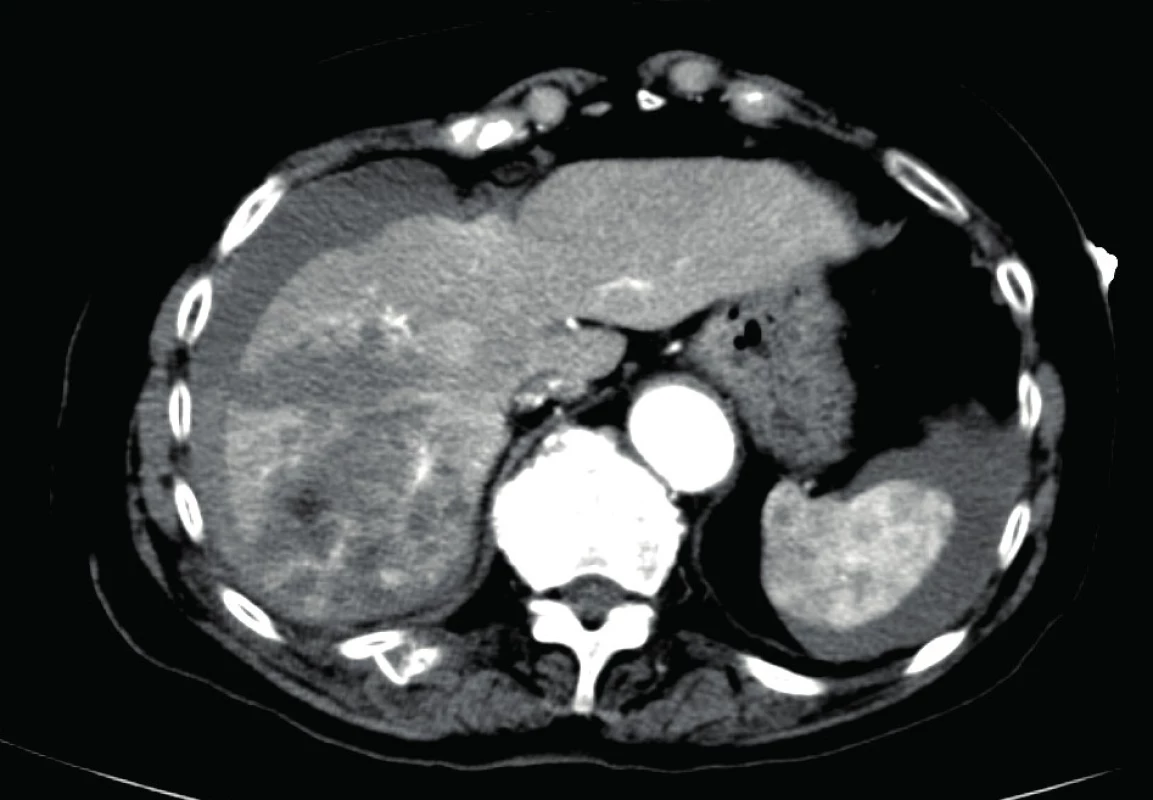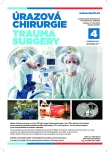Blunt liver and splenic trauma due to distal rib fracture
Authors:
Martin Popelka; Michal Mašek
Authors place of work:
Klinika úrazové chirurgie LF MU a FN Brno
Published in the journal:
Úraz chir. 25., 2017, č.4
Summary
Introduction:
The aim of this paper was to retrospectively assess the likelihood of blunt liver and splenic trauma in a closed fracture of the distal ribs.
Material and method:
Patients over the age of 18, regardless of gender, in a time horizon of 18 months were enrolled in the group. The acquired group of patients included a total of 484 persons with confirmed closed rib fractures. 320 of these were males and 164 were females. Furthermore, only those patients were used for our research investigation that were found to have suffered rib fractures in the area of the 9th-12th rib and also suffered liver or splenic trauma.
The AAST (American Association for the Surgery of Trauma) classification system was applied to assess liver and splenic trauma which is currently the most widespread scoring system for this trauma. A CT scan is the basic examination for this classification system.
Results:
The total number of patients diagnosed with closed rib trauma was 484 people. Of this number, in 12 % of cases people had suffered liver or splenic trauma. In connection with the incriminating fracture of distal ribs 14 % were found to have liver trauma and 21 % splenic trauma. The most common cause of trauma of the investigated group of patients was polytrauma.
Surgical treatment was required by 10 patients with liver and 14 patients with splenic trauma.
During the investigated time period no open rib fractures and penetrating abdominal trauma was recorded.
Conclusion:
The results showed that in connection with a closed distal rib fracture it was found that 14 % were liver trauma and 21% splenic trauma. These findings also correspond to foreign data. This incidence is not negligible and therefore an initial ultrasound scan of the abdomen should be performed as standard event of a stable patient with a negative clinical abdominal finding.
Keywords:
Rib fracture, liver trauma, splenic trauma.
Introduction
Blunt liver and splenic trauma could be a serious complication for a rib fracture, particularly in the area of the 9th–12th rib. The aim of our research investigation is to assess the likelihood that this blunt trauma can arise due to a closed rib fracture and compare our results with those found by foreign studies.
The liver and spleen are the most frequently injured organs in the abdominal cavity. This can result in blunt and penetrating trauma. There may often be severe bleeding and the risk of the patient suffering hemorrhagic shock. The extent of the bleeding often corresponds to the degree of the trauma. It is for this reason that the possibility of injury to these organs must always be considered in distal rib fractures and apart from the standard clinical examination an ultrasound scan of the abdomen is required to rule out this trauma.
Material and method
Patients over the age of 18, regardless of gender, were retrospectively enrolled in the group in a time horizon of 18 months from 1 January 2016 to 30 June 2017. The AMIS information system of University Hospital Brno was used to collect the data. Patients were recruited diagnosed with rib fracture and multiple rib fractures, liver trauma, splenic trauma and polytrauma. The total acquired group of patients was 484 with confirmed rib fractures, of which 320 were males and 164 females. Our further research investigation involved only those patients diagnosed with rib fractures in the area of the 9th–12th rib who also suffered blunt liver or splenic trauma.
All these patients were treated at the trauma outpatient department or emergency department at University Hospital Brno and were fully examined. The search criteria for our research were rib fractures, their localisation (side, part) and connection with intra-abdominal trauma. The AAST (American Association for the Surgery of Trauma) classification system was applied for assessing liver and splenic trauma.
Results
The total number of patients diagnosed with closed rib fractures was 484, of which 320 were males and 164 females. The most frequently affected age group were patients aged 30 to 60.
In the monitored group of 484 patients 45 % of fractures were on the right, 44 % on the left and 11 % were multiple bilateral rib fractures. 6 % of fractures were localised in the area of the 1st–4th rib, 27 % in the middle area of the 5th–8th rib and 21 % in the area of the 9th–12th rib. The rest of the cases involved multiple rib fractures of several parts with a maximum in the area of the 5th–12th rib constituting 19 % of cases. Out of the total number of 484 affected patients, 57 of the cases, constituting 12 %, involved intra-abdominal liver and splenic trauma.
161 patients suffered incriminating right-sided trauma of the 9th–12th rib, of these 22 (14 %) were confirmed to have suffered liver trauma (Tab.1) In this sample 10 patients were diagnosed with 1st degree liver trauma, 6 with 2nd degree, 2 with 3rd degree, 3 with 4th degree and 1 with 5th degree trauma (Graph 1). 6th degree liver trauma, i.e. complete avulsion was not found.

A total of ten patients required surgery. One case required partial hepatic resection and two cases perihepatic packing. The rest of the cases just needed to be treated with sutures, or Tachosil or Surgicel. 12 patients with blunt liver trauma received successful conservative treatment, i.e. regular ultrasound scans showed no progressive condition. Not one treated patient died.
As for the causes, 95% patients suffered polytrauma due to a road accident, only one patient (5 %), had combined liver and rib trauma after falling on the right side in a tram.
163 patients suffered left-sided trauma of the 9th–12th rib, of these 35 (21 %) were simultaneously diagnosed with splenic trauma (Tab. 2). 16 patients had 1st degree trauma, 11 had 2nd degree trauma, 2 had 3rd degree trauma and 6 suffered 4th degree lacerations (Graph 2). No case of the most severe 5th degree trauma was recorded. The most common cause in 83 % of cases was a road accident, 14 % were falls and 3 % were different accidents. 89 % involved polytrauma. Not one treated patient died.

14 emergency laparotomies were performed ending in splenectomies. The rest, i.e. 21 cases received conservative treatment with repeat ultrasound scans showing no progressive condition with the need for intervention. No two-stage splenic rupture was recorded in our time horizon.
There was also no record of open thoracic trauma and penetrating abdominal trauma in the investigated period.
Discussion
Rib fracture is the most common trauma of the chest wall in the adult population [2] as is also indicated by the relatively high number of investigated patients (484 people) we found in a period of 18 months. Therefore it turns out that on average every month 27 patients with this diagnosis were treated in our department. The causes of the accident were different, the most are being a road accidents and falls. Rib fractures are divided into isolated, serial and block. The higher the number of fractures the higher the degree of secondary traumas such as trauma of the liver or spleen and other organs as presented by Seongsik Park [8]. His study shows that the frequency of combined intra-abdominal traumas in patients with rib trauma ranges between 10 % and 16 % [8]. Our research investigation is consistent with these results when intra-abdominal trauma resulted in 12 % of cases. There is also a paper that presents a higher frequency of as much as 21.7 % [5].



Another interesting finding from these foreign studies is that the most common abdominal organ trauma associated with distal rib fracture is the liver followed by the spleen (then the bowel, pancreas and kidneys) [8, 11]. It can be assumed that this is because of the bigger size and mass of the liver (1500 g) as opposed to the spleen (100–200 g). However this result is not consistent with our study.
The reason could be an insufficiently large group of patients or different specification of a trauma.
Our investigation shows that the most frequently injured organ is the spleen and not the liver. This findings corresponds with the generally recognised postulate that splenic trauma predominates due to it has longer free ligaments. And the liver is better covered by the ribcage.
Of the 484 patients with rib fracture, 35 (7 %) of cases suffered blunt splenic trauma and 22 (5 %) of cases blunt liver trauma. What is also important is that most studies do not address what degree of trauma is involved. Our results show the most common is 1st and 2nd degree of trauma. 45 % and 27 % involved the liver and 46 % and 31 % involved the spleen (see Graph 1, 2). So we did not record the highest or most severe degree of trauma in our study. Most likely such severe liver or splenic trauma cannot be compatible with life so these patients do not reach hospital or die immediately on admission and therefore do not undergo a proper diagnosis.
Fractures of the 10th–12th rib could be considered as a severe trauma which usually result from the action of a large force and thus should automatically arouse the suspicion of possible intra-abdominal trauma even in hemodynamically stable patients with a negative clinical abdominal finding. Therefore in our department we perform standard abdominal ultrasound scans on these patients. If there is only a minimum perisplenic or perihepatic margin of fluid or a small intraparenchymal haemorrhage and the patient is hemodynamically stable, conservative treatment can be applied. In other words, observation on a monitored bed and an early ultrasound scan. Most 1st and 2nd degree lesions according to the AAST classification can be treated this way. If the ultrasound shows a greater amount of fluid in the abdominal cavity and the general condition of the patient so allows, i.e. the patient is stable or therapeutically stabilised, we also perform a CT scan with contrast dye which will more precisely determine the extent of abdominal cavity trauma and the possible source of bleeding. At this point we must not neglect to mention the option of embolization performed by an interventional radiologist. This involves selective or super-selective catheterisation of a bleeding artery with subsequent use of a microcoil, tissue glue, gelatine foam or nitinol plug. This mini-invasive endovascular treatment can be considered only in hemodynamically stable patients or patients stabilised with infusions. We opt for exploratory laparotomy in hemodynamically unstable patients with fluid in the abdomen and procedure according to the finding. (splenectomy, perihepatic packing, partial hepatic resection, treatment using Tachosil etc.)
Conclusion
Based on the data we acquired, 14 % of blunt liver and 21 % of blunt splenic trauma were found in connection with distal rib fracture. The most common is 1st and 2nd degree trauma. The most common cause of trauma was road accident (liver 95 %, spleen 83 %). Ten patients with liver and 14 patients with splenic trauma required surgical treatment. The higher the number of fractured ribs, the higher the degree and risk of associated trauma. These findings also correspond to foreign data.
In view of the ascertained facts, an initial ultrasound scan of the abdomen should be performed as standard event in a stable patient with a negative clinical finding on the abdomen.
Zdroje
-
Bergeron, E., Lavoie, A., Clas, D. et al. Elderly trauma patients with rib fractures are at greater risk of death and pneumonia. J Trauma. 2003, 54, 478–485. [online]. [cit. 2017-09-09].
-
Černý, J. Špeciálna chirurgia. 2. vyd. Martin : Osveta, 1990. ISBN 80-217-0056-4.
-
Chmatal, P., Zavoral, M., Fencl, P. Gunshot liver trauma with disruption of the right hepatic duct managed by surgery, radiology, and endoscopy: a case report. Int Surg. 2004, 89, 67–71. [online]. In: . [cit. 2017-09-09].
-
Hájek, M. Chirurgie praktického lékaře. 1. vyd. Praha : Grada Publishing, 1995. 323 s. ISBN 80-7169-108-9
-
KIM, JH, DO, BS, LEE, SB et al. The correlation of abdominal organ injury in rib fracture patients. J Korean Soc Emerg Med. 2005, 16, 562–565. [online]. [cit. 2017-09-09].
-
Lacman, J., Charvát, F., Mašková, J. Zobrazovací metody při podezření na poranění jater. Trauma Jater. 2004, ISBN 80-860-1357. [online]. [cit. 2017-09-09].
-
Ott, R., Schon, MR, Seidel, S. et al. Surgical management, prognostic factors, and outcome in hepatic trauma. Unfallchirurg, 18, 2004 : 132–138. [cit. 2017-09-09].
-
Seongsik, P. Clinical Analysis for the Correlation of Intra-abdominal Organ Injury in the Patients with Rib Fracture. Korean J Thorac Cardiovasc Surgery. 2012, 45, 246. [online]. [cit. 2017-09-09].
-
Shweiki, E, Klena, J, Wood, GC, Indeck, M. Assessing the true risk of abdominal solid organ injury in hospitalized rib fracture patients. J Trauma. 2001;50 : 684–688. [online]. [cit. 2017-09-09].
-
Sirmali, M, Turut, H, Topcu, S, et al. A comprehensive analysis of traumatic rib fractures: morbidity, mortality and management. Eur J Cardiothorac Surg. 2003;24 : 133–138. [online]. [cit. 2017-09-09].
-
Subedi, N, Yadav, BN, Jha, S. Liver and Spleen Injuries and Associated Rib Fractures: An Autopsy Study. J Forensic Res. 2014;10.4172/2157-7145.1000240. [online]. [cit. 2017-09-09].
-
Třeška, V, Horský, J, Černý, V. Poranění jater. Trauma jater. 2014;04-4-06. [online]. In: . [cit. 2017-09-09].
-
Way, L.W. a kolektiv. Současná chirurgická diagnostika a léčba. Vyd. 1. Praha: Grada Publishing, 1998. ISBN 80-7169-397-9
Štítky
Chirurgie všeobecná Traumatologie Urgentní medicínaČlánek vyšel v časopise
Úrazová chirurgie

2017 Číslo 4
- Metamizol jako analgetikum první volby: kdy, pro koho, jak a proč?
- Stillova choroba: vzácné a závažné systémové onemocnění
- Perorální antivirotika jako vysoce efektivní nástroj prevence hospitalizací kvůli COVID-19 − otázky a odpovědi pro praxi
- Hojení análních fisur urychlí čípky a gel
- Antidepresivní efekt kombinovaného analgetika tramadolu s paracetamolem
Nejčtenější v tomto čísle
- Abdominal compartment syndrome in polytrauma
- Blunt liver and splenic trauma due to distal rib fracture
- Surgical stabilization of chest wall –development of the method and contemporary trends
- Evaluation of medium-term outcomes of surgical treatment of talus neck fractures at the Department of Trauma Surgery, University Hospital Brno

